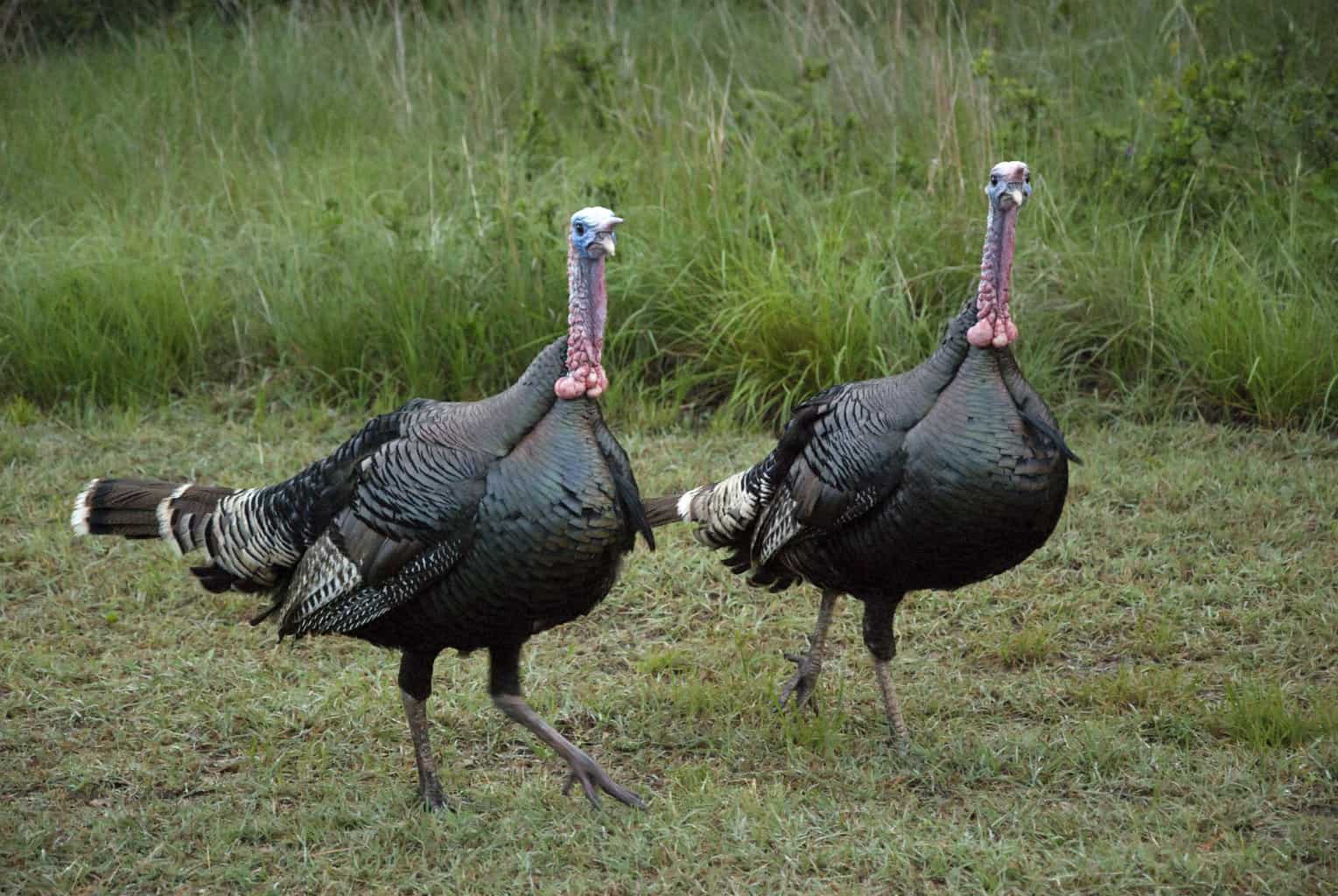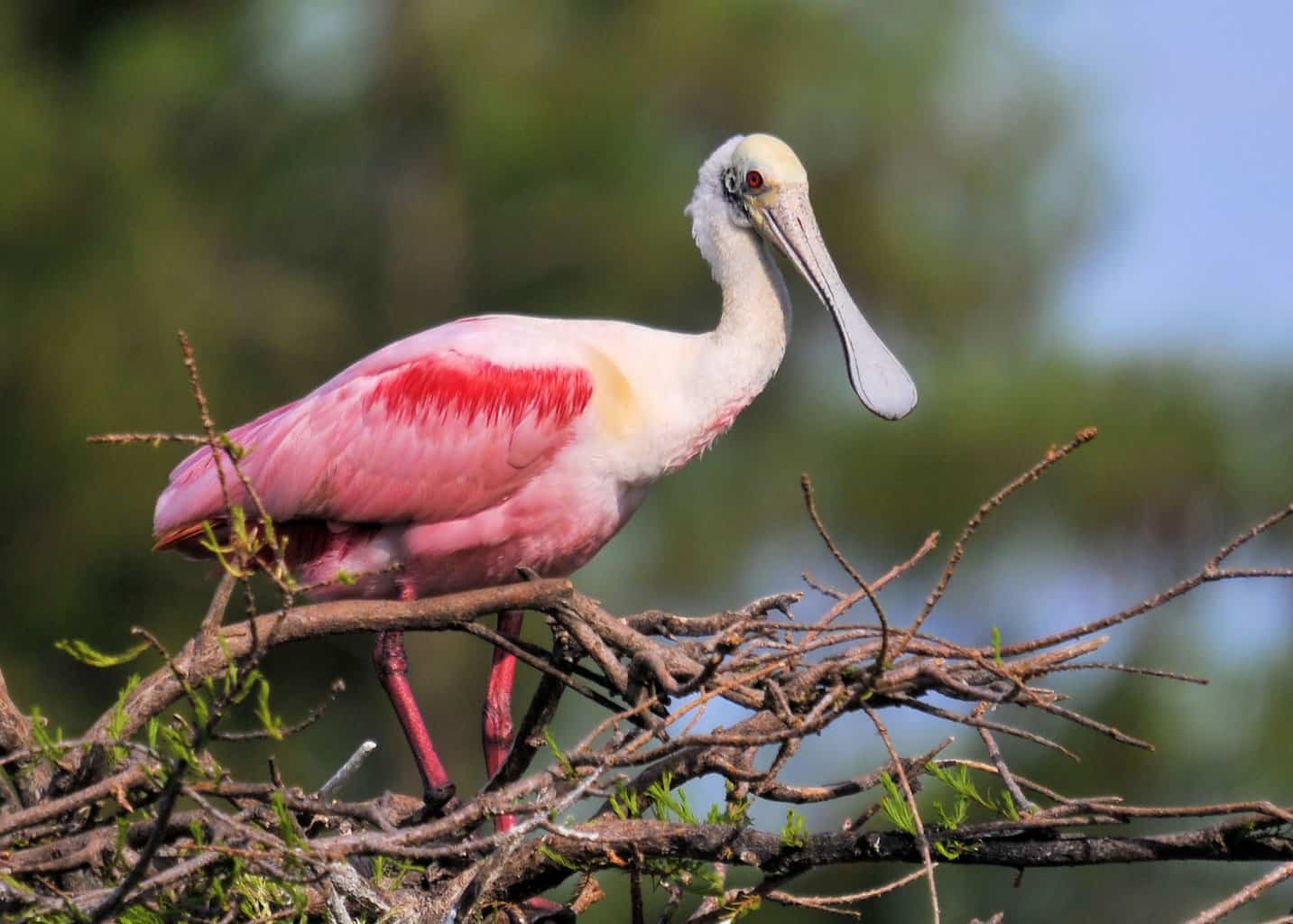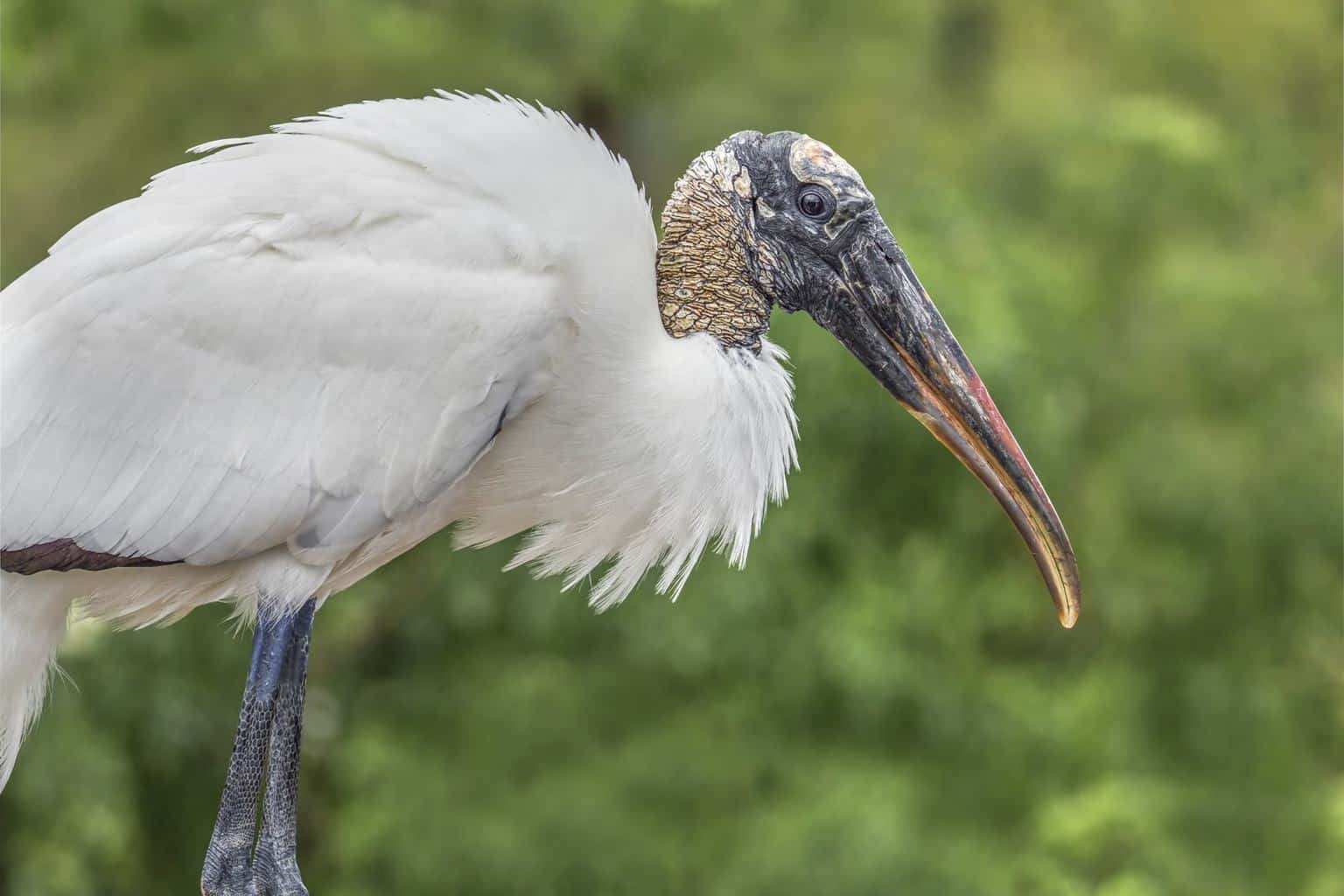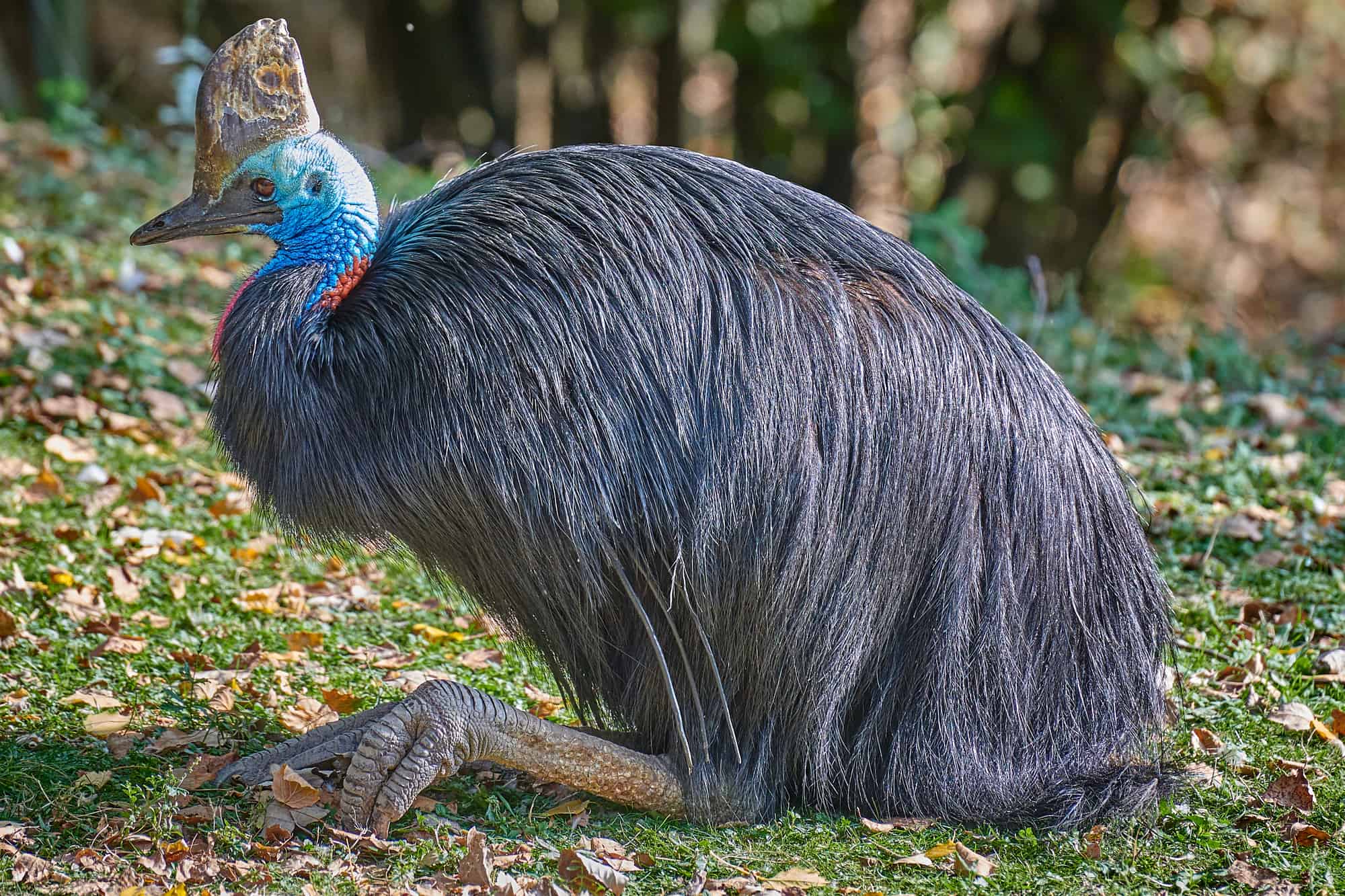Birds are known for their colorful plumage and feathered adornments, yet some species exhibit a distinctive lack of feathers.
In the animal kingdom, baldness is a rare trait, but a number of bird species have evolved partially or fully bare heads and necks.
This unusual adaptation likely serves important functions related to heat regulation, communication, and feeding behaviors. Let’s take a look at some of the most iconic bald bird species across the globe!
Wild Turkey

- Scientific Name: Meleagris gallopavo
- Length: 110-115 cm (43.3-45.3 in)
- Weight: 2,500-10,800 g (88.2-381.0 oz)
- Wingspan: 125-144 cm (49.2-56.7 in)
What they look like: Wild Turkeys are large birds with a distinctive appearance — almost any schoolchild in the US can recognize the Wild Turkey! They have long legs, wide, rounded tails, and a small bald head on a long, slim neck. Their plumage is dark overall with a bronze-green iridescence, and their wings are dark with white bars. The bare skin on the head and neck can vary in color, from red to blue to gray.
Where they live: Wild Turkeys are found in mature forests, particularly those with nut trees like oak, hickory, or beech, interspersed with open areas such as pastures, fields, and orchards. They can also be seen in woodsy backyards and along roads.
Interesting facts: Wild Turkeys are agile fliers despite their size. They forage on the ground, feeding on nuts, berries, insects, and snails. Males display during the breeding season by puffing up their feathers, spreading their tails into a fan, and gobbling. They are polygamous, mating with as many hens as possible.
Lappet-Faced Vulture

- Scientific Name: Torgos tracheliotos
- Length: 95-115 cm (37-45 in)
- Weight: 4.4 to 9.4 kg (9.7 to 20.7 lb)
- Wingspan: 2.5-2.9 m (8.2-9.5 ft)
What they look like: The Lappet-faced Vulture is a massive bird and ranks as the longest and largest winged vulture in its range. It has mostly black plumage with contrasting white feathers on the thighs. The underside can range from pure white to buff brown. Like many vultures, it has a bald head, which can vary in color from reddish to pink on the back of the head and gray on the front. The head features fleshy folds on the sides.
Where they live: Lappet-faced Vultures have a patchy distribution through much of Africa and the Arabian Peninsula. They prefer to live in dry savannah, thornbush, arid plains, deserts with scattered trees in wadis, and open mountain slopes.
Interesting facts: Lappet-faced vultures are powerful and aggressive scavengers, often starting to tear through the skin of carcasses on their own. They are known for their ability to assert themselves over other vultures and access the tough hides and muscles of large mammals that others cannot penetrate.
Helmeted Guineafowl

- Scientific Name: Numida meleagris
- Length: 53-58 cm (21-23 in)
- Weight: Approximately 1.3 kg (2.9 lb)
What they look like: The Helmeted Guineafowl is a large bird with a round body. It has a gray-black plumage with white speckles. Its head is unfeathered and adorned with a dull yellow or reddish bony knob. The wings are short and rounded, and the tail is similarly short. There’s considerable variation in the appearance of different subspecies, particularly in the shape, size, and color of the casque, and the bird’s facial wattles.
Where they live: Helmeted Guineafowl thrive in warm, fairly dry, and open habitats with scattered shrubs and trees, such as savannas and farmland. They are widespread throughout much of Africa.
Interesting facts: This species is well-known for its tick-eating habit, which can help control tick populations and reduce the spread of tick-borne diseases. Helmeted Guineafowl are often domesticated and are found in various parts of the world, including the West Indies, North America, Australia, and Europe, due to their adaptability and usefulness.
Roseate Spoonbill

- Scientific Name: Platalea ajaja
- Length: 71-86 cm (28-34 in)
- Weight: 1.2-1.8 kg (2.6-4.0 lb)
- Wingspan: 120-133 cm (47-52 in)
What they look like: The Roseate Spoonbill is a large, striking wading bird. Adults exhibit a distinctive deep pink plumage with a greenish head and white neck, back, and breast. During the breeding season, both males and females develop a tuft of pink feathers in the center of the breast. The bill, a defining feature, is long, grey, and spatula-shaped.
Where they live: Roseate Spoonbills can be found in both South and North America, including regions in Texas, Florida, southwest Louisiana, South America (east of the Andes), and coastal areas of the Caribbean, Central America, Mexico, and the Gulf Coast of the United States. They have also expanded their range, notably in Georgia and South Carolina. Their nesting sites include shrubs or trees, often mangroves.
Interesting facts: Their distinctive pink coloration is derived from the carotenoid pigment canthaxanthin, similar to the American flamingo. It doesn’t become vibrant until they are about 3 years old.
Marabou Stork

- Scientific Name: Leptoptilos crumenifer
- Length: Up to 152 cm
- Weight: 4.5-9 kg
- Wingspan: 3.7 m (maximum reported 4.06 m)
What they look like: The Marabou Stork is a massive bird with distinct features. It has a bare head and neck, a black back, and white underparts. The bird’s most notable features include a huge bill, a pink gular sac at its throat, a neck ruff, and white legs with black wings. Both males and females look similar, while young birds are browner and have smaller bills. Full maturity is reached at up to four years.
Where they live: Marabou Storks are native to sub-Saharan Africa. They can be found in various habitats, including wet and arid areas. They often live near human habitation, particularly landfill sites.
Interesting facts: Marabou Storks are often referred to as “undertaker birds” due to their distinctive appearance, resembling an undertaker’s attire when viewed from behind, with cloak-like wings and back, skinny white legs, and sometimes a large white mass of “hair.”
King Vulture

- Scientific Name: Sarcoramphus papa
- Length: 26-32 inches (67-81 cm)
- Weight: 6-10 pounds (2.7-4.5 kg)
- Wingspan: 4-7 feet (1.2-2 meters)
What they look like: The King Vulture is an impressive bird with mostly white plumage, occasionally with a rose-yellow tinge. It boasts a striking combination of gray to black wing coverts, flight feathers, and tail. The most distinctive features are its featherless head and neck, which exhibit vibrant colors, including red, orange, blue, purple, and yellow. It has broad wings, a short, square tail, and gray legs with long, thick claws.
Where they live: King Vultures are found in Central and South America, inhabiting a vast region that stretches from southern Mexico to northern Argentina. They predominantly reside in tropical lowland forests but can also be spotted in savannas and grasslands adjacent to forests. They are often near swamps or marshy areas within forests and can be found in various altitudes, including places above 8,000 feet in the Andes.
Interesting facts: The King Vulture plays a crucial role as a scavenger, often being the first to make the initial cut into a fresh carcass. Its powerful bill enables it to open hides and grant access to smaller vulture species that can’t perform this task.
Ocellated Turkey

- Scientific Name: Meleagris ocellata
- Length: 70-122 cm (28-48 inches)
- Weight: Females: Approximately 3 kg (6.6 lb), Males: Approximately 5 kg (11 lb)
What they look like: Ocellated turkeys are smaller than their North American counterparts. Both males and females are covered in feathers that range from bronze to green. Although females may display more green in their plumage, there are few other ways to differentiate between males and females. Unlike other turkeys, ocellated turkeys lack the characteristic beard.
Where they live: Ocellated turkeys primarily inhabit the Yucatán Peninsula in Mexico, including regions in Quintana Roo, Campeche, Yucatán, Tabasco, and Chiapas, as well as parts of Belize and northern Guatemala. Their range covers approximately 130,000 square kilometers (50,000 square miles).
Interesting facts: During the breeding season, male ocellated turkeys engage in an elaborate courtship display. This display involves tapping their feet, moving their tail feathers, vibrating their wings, and dragging their wingtips on the ground to attract females.
Bare-Faced Bulbul
- Scientific Name: Nok hualon
- Length: Approximately 20 cm (7.8 in)
- Weight: 32-40 g (1.12-1.4 oz)
What they look like: The Bare-faced Bulbul has olive-green plumage and a remarkable bare pink face with bluish skin surrounding the eyes. Their breast and belly are fawn-grey, while the upper parts of their body are olive. The throat is off-white in color.
Where they live: The Bare-faced Bulbul is known to inhabit the limestone karst region near Pha Lom in central Laos. It is likely that this species is entirely restricted to this specific habitat, although similar birds have been observed at another site in 1995.
Interesting facts: The Bare-faced Bulbul is known for its unique, featherless face, setting it apart from most other songbirds in Asia. Its distinctive facial features make it a remarkable and easily identifiable bird. This species was only discovered in 2009, which makes it the first new species of bulbul in Asia in nearly 100 years.
Northern Bald Ibis

- Scientific Name: Geronticus eremita
- Length: Approximately 70–80 cm (28–31 inches)
- Weight: Around 1.0–1.3 kg (35–46 ounces)
- Wingspan: Approximately 125–135 cm (49–53 inches)
What they look like: The Northern Bald Ibis is an attention-grabbing, glossy black bird known for its unique appearance. Its plumage is black, adorned with bronze-green and violet iridescence. A notable feature is the dull red, unfeathered face and head, accompanied by a long, curved red bill. Its legs are also red. In flight, it displays powerful and shallow wing beats, creating a distinctive profile.
Where they live: The Northern Bald Ibis is typically found in barren, semi-desert, or rocky habitats, often near running water. Although they were once found in the European Alps, Northern Africa, and the Middle East, today about 99% of Northern Bald Ibis are in Morocco.
Interesting facts: They were thought to be extinct until a small number of these birds were rediscovered in Syria in 2002. There were fewer than 10 left in Syria by 2019. Intentional breeding colonies have been established in Morocco, Spain, Italy, Austria, and Turkey. They are Endangered, but no longer considered Critically Endangered.
Capunchinbird

- Scientific Name: Perissocephalus tricolor
- Length: Approximately 40 centimeters (16 inches)
- Weight: Between 340 and 420 grams (12 and 15 ounces)
What they look like: The Capuchinbird is a large passerine bird with a heavy bill. It is mostly brown, although the belly and undertail are orangeish in color. They have a vulture-like bald head that is covered with blue skin. While they are young, they may have a few feathers on their head.
Where they live: Capuchinbirds are primarily found in humid forests in northeastern South America. They inhabit regions with elevations up to 1,400 meters (4,600 feet), although they are typically seen at altitudes below 600 meters. Their range is mostly situated north of the Amazon River and east of Rio Negro, covering areas in Colombia, Venezuela, Brazil, and The Guianas.
Interesting facts: Capuchinbirds are known to gather in leks where they produce a distinct vocalization. Describing their “song” is challenging, as it has been compared to the distant sound of a chainsaw or even the mooing of a young cow. This unique vocalization adds to the bird’s mystique and sets it apart from other bird species.
White-Headed Vulture

- Scientific Name: Trigonoceps occipitalis
- Length: 72–85 centimeters (28–33 inches)
- Weight: Females: 4.7 kilograms (10 pounds), Males: 4 kilograms (8.8 pounds) or less
- Wingspan: 207–230 centimeters (81–91 inches)
What they look like: The White-headed Vulture is a medium-sized Old World vulture with a pink beak and a white crest. Featherless areas on its head are pale, and it has dark brown upperparts with black tail feathers. However, its most recognizable characteristic is the strong contrast between the black upper parts and the white feathers on its lower parts and legs, making it easily distinguishable from other vulture species.
Where they live: White-headed Vultures are found throughout sub-Saharan Africa, with their range stretching from Senegal and The Gambia to Somalia in the east and South Africa and Eswatini in the south. Although they are locally uncommon to common, recent population estimates suggest a decline. They tend to avoid areas of human habitation and are often seen in protected regions, like the Kruger National Park in South Africa, which holds a significant population of the species.
Interesting facts: Interestingly, females are quite a bit larger than males. For most vultures, the opposite is true. Their diet mostly consists of carrion, but they will also prey on species like the slender mongoose, the monitor lizard, the tree squirrel, and the scrub hare.
Wood Stork

- Scientific Name: Mycteria americana
- Length: 33–45 inches (83–115 cm)
- Weight: 5.5–7.3 pounds (2.5–3.3 kg)
- Wingspan: 55–71 inches (140–180 cm)
What they look like: The Wood Stork is a large wading bird with a dark grey, scaly, featherless head and neck. The plumage of the body is mostly white, with the exception of the tail and some wing feathers, which are black with a greenish-purplish sheen. Adult wood storks have long, black, downward-curved bills that are wide at the base, and their legs and feet are dark with pink toes during the breeding season. Males and females look a lot alike.
Where they live: Wood storks are found in subtropical and tropical habitats throughout the Americas, including the Caribbean. They are the only stork species that breeds in North America. In the United States, small breeding populations can be found in Florida, Georgia, and the Carolinas, while in South America, they are resident.
Interesting facts: Wood storks build large stick nests, which can be found in colonies with up to 25 nests in a single tree. The nests are made from sticks and green twigs, often placed in trees near water.
Southern Cassowary

- Scientific Name: Casuarius casuarius
- Length: Approximately 127 to 170 cm
- Weight: Varies but typically between 17 and 70 kg
What they look like: The Southern Cassowary is a large, intimidating, flightless bird with stiff, black plumage. It has a blue face, a long neck with red coloring, and two red wattles hanging around its throat. A horn-like brown casque adorns its head. The bill ranges from 4-7.5 inches. Females are larger than males, and juveniles have brown stripes on their feathers.
Where they live: They are found in Indonesia, Papua New Guinea, and northeastern Australia, primarily in tropical rainforests, savannah forests, or mangrove stands.
Interesting facts: They are known for their ability to attack and even kill humans, even though this is rare. They are essential for rainforest ecosystems, feeding on fallen fruits and some toxic to others. Their diet also includes fungi, insects, and small vertebrates.
Vulturine Guineafowl

- Scientific Name: Acryllium vulturinum
- Length: 61–71 centimeters (24–28 inches)
- Weight: 2.2 to 3.5 lbs. (1-1.6 kg)
What they look like: The Vulturine Guineafowl is characterized by a round body and small head. Its distinguishing features include an elongated wingspan, neck, legs, and tail, setting it apart from other guineafowl species. Adults sport a bare blue face and a black neck. Notably, the Vulturine Guineafowl bears a striking resemblance to vultures due to its lengthy bare neck and head. However, it is not a vulture and is instead a guineafowl.
Where they live: Vulturine Guineafowls are native to northeast Africa, specifically found in regions spanning from southern Ethiopia through Kenya and just into northern Tanzania. These birds inhabit diverse habitats within their range.
Interesting facts: They almost never fly, and instead, they are accomplished runners. They will sometimes fly up to perch in trees for safety at night.
Enjoy the Fascinating Bald Birds of the World!
The bald birds profiled in this article highlight the immense diversity of the bird world.
From vultures to storks, turkeys, and endangered species, bald birds have evolved all over the world, adapting to habitats ranging from scorching deserts to tropical rainforests. While we may be most familiar with birds bursting with colorful feathers, these bald species reveal that feathers aren’t always necessary!
Protecting the ecosystems these unique species rely on will be key to their survival. When we take the time to appreciate how diverse the bird kingdom is, it’s an important reminder of the value of conservation.

